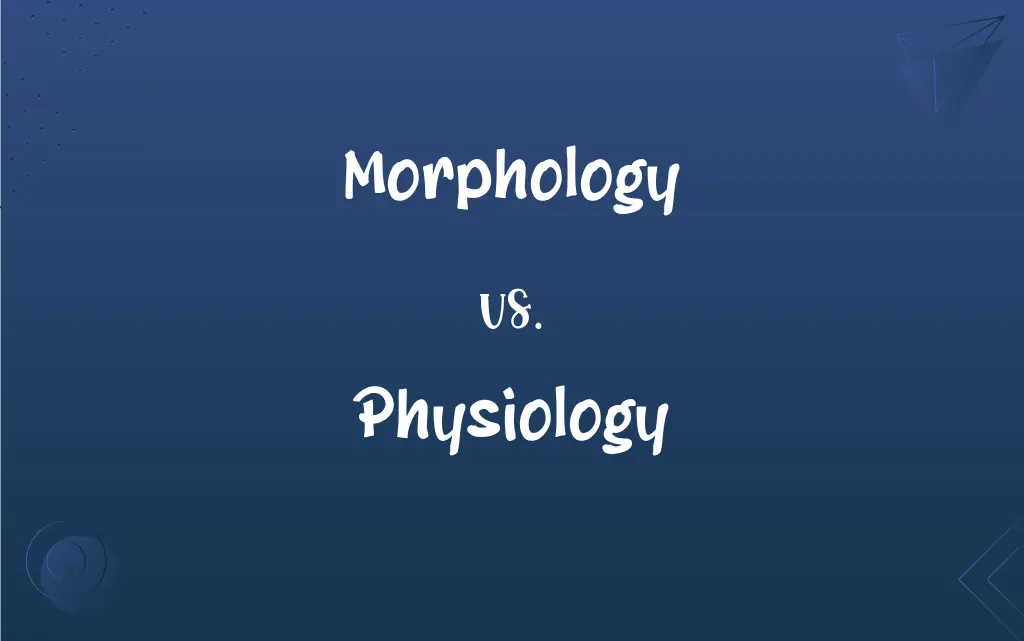Morphology vs. Physiology: What's the Difference?
Edited by Aimie Carlson || By Janet White || Published on February 12, 2024
Morphology studies the form and structure of organisms, while physiology examines their functions and processes.

Key Differences
Morphology is the branch of biology that deals with the form and structure of organisms, including their size, shape, and structure. Physiology focuses on the functions and processes of the various systems within organisms.
Morphologists study the external and internal structures, such as bones and muscles. Physiologists analyze how these structures function, such as how muscles contract or how the heart pumps blood.
Morphology provides insights into how organisms evolved and adapted physically. Physiology helps in understanding how these adaptations function to support life processes.
Morphological research often involves dissection and microscopy to observe structures. Physiological studies typically involve experiments to observe functions, such as monitoring heart rate or brain activity.
Morphology is closely related to anatomy and taxonomy. Physiology intersects with biochemistry and medicine in understanding how bodily systems operate and respond to changes.
ADVERTISEMENT
Comparison Chart
Primary Focus
Structure and form of organisms.
Functions and processes within organisms.
Study Methods
Dissection, microscopy, physical measurements.
Experiments, function monitoring, lab tests.
Key Insights
Evolutionary and physical adaptations.
Functional adaptations and processes.
Applications
Taxonomy, evolutionary biology.
Medicine, healthcare, sports science.
Related Fields
Anatomy, taxonomy.
Biochemistry, medicine.
ADVERTISEMENT
Morphology and Physiology Definitions
Morphology
Examining organism's external and internal structure.
Plant morphology involves studying the structure of leaves and stems.
Physiology
The study of functions and processes in living organisms.
Human physiology focuses on how organs like the heart and lungs function.
Morphology
The study of the form and structure of organisms.
The morphology of the beetle species was characterized by a unique shell pattern.
Physiology
A field closely linked with medicine and health sciences.
Physiology is fundamental in developing new medical treatments.
Morphology
Analysis of physical forms in different species.
Comparative morphology shows how different bird species have evolved distinct beak shapes.
Physiology
Involves understanding biological mechanisms.
Plant physiology includes studying photosynthesis and nutrient uptake.
Morphology
A branch of biology related to anatomy and taxonomy.
Morphology is crucial in classifying new species.
Physiology
Examines responses of organisms to environmental changes.
Environmental physiology studies how animals adapt to extreme temperatures.
Morphology
Used to understand evolutionary adaptations.
The morphology of fish fins reveals their adaptation to aquatic environments.
Physiology
Investigates how bodily systems operate and interact.
Cardiovascular physiology examines how blood circulates throughout the body.
Morphology
The branch of biology that deals with the form and structure of organisms without consideration of function.
Physiology
The biological study of the functions of living organisms and their parts.
Physiology
All the functions of a living organism or any of its parts.
Physiology
A branch of biology that deals with the functions and activities of life or of living matter (as organs, tissues, or cells) and of the physical and chemical phenomena involved.
Physiology
(obsolete) The study and description of natural objects; natural science.
Physiology
The science which treats of the phenomena of living organisms; the study of the processes incidental to, and characteristic of, life.
Physiology
A treatise on physiology.
Physiology
The branch of the biological sciences dealing with the functioning of organisms
Physiology
Processes and functions of an organism
FAQs
How is morphology used in taxonomy?
Morphology helps classify organisms based on physical characteristics.
What role does physiology play in sports science?
Physiology helps understand how the body functions during physical activity.
What does morphology study?
Morphology studies the form and structure of organisms.
How does physiology relate to medicine?
Physiology provides insights crucial for medical science and healthcare.
Are morphology and anatomy the same?
Morphology is broader, including external structures, while anatomy often focuses on internal structures.
Do morphologists study genetic aspects?
Morphology primarily focuses on physical forms, not genetics.
How does environmental physiology work?
It studies how organisms adapt to environmental factors like temperature.
Is microscopy important in morphology?
Yes, microscopy is a key tool in examining small-scale structures in morphology.
What is the main focus of physiology?
Physiology focuses on the functions and processes within organisms.
Can physiology be applied to plant studies?
Yes, plant physiology studies functions like photosynthesis in plants.
Can morphology reveal evolutionary history?
Yes, morphology can provide clues about an organism's evolutionary adaptations.
Do morphologists study living or dead organisms?
Morphologists study both, examining structures of living and preserved specimens.
How does physiology relate to biochemistry?
Physiology overlaps with biochemistry in studying chemical processes in organisms.
Is human physiology different from animal physiology?
While there are similarities, human physiology has unique aspects compared to other animals.
Can physiology help in drug development?
Yes, understanding body functions is essential in developing effective drugs.
Are morphological studies done on extinct species?
Yes, morphology can be used to study the form of extinct species through fossils.
What's the role of physiology in fitness?
Physiology helps understand and improve body functions during exercise.
Can morphology predict evolutionary trends?
Morphology can provide insights but not definitive predictions about evolutionary trends.
How does physiology aid in understanding diseases?
Physiology helps explain how diseases affect bodily functions.
What is structural morphology?
Structural morphology focuses on the physical structures of organisms.
About Author
Written by
Janet WhiteJanet White has been an esteemed writer and blogger for Difference Wiki. Holding a Master's degree in Science and Medical Journalism from the prestigious Boston University, she has consistently demonstrated her expertise and passion for her field. When she's not immersed in her work, Janet relishes her time exercising, delving into a good book, and cherishing moments with friends and family.
Edited by
Aimie CarlsonAimie Carlson, holding a master's degree in English literature, is a fervent English language enthusiast. She lends her writing talents to Difference Wiki, a prominent website that specializes in comparisons, offering readers insightful analyses that both captivate and inform.






































































